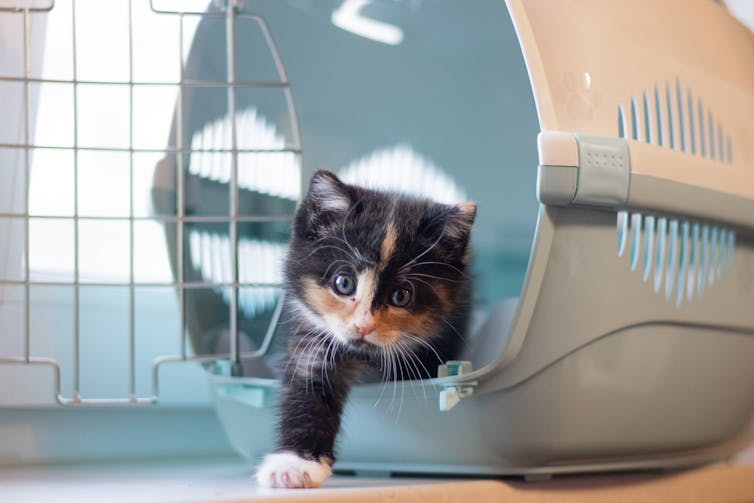Why you should train your cat – and how to do it
The pandemic has led to a surge in first-time pet owners and people adopting puppies and kittens. While even inexperienced owners assume that a new puppy needs some training, people rarely think the same is true of kittens.
But just like dogs, cats need support to adjust to living with us. Simple forms of exercise can be good for your well-being.
Compared to dogs, cats have different historical relationships with humans. Cats have never been selectively bred to improve their ability to cooperate and communicate with us, or to perform work tasks such as herding, hunting, or guarding. However, research shows that they can recognize and respond to our subtle social cues and are trained to perform similar tasks as dogs.
However, we are unlikely to need a cat that “walks well” on a leash or settles down quietly in the pub. And cats usually need less support than dogs to master toilet training – providing the right litter box is usually sufficient.
But we’re missing a trick just thinking about training pets to make our lives easier. Myself and my colleague Daniel Cummings of animal welfare organization Cats Protection would argue that there are many potential benefits for the cat as well. At an animal shelter, for example, training can be a useful tool in improving a cat’s exploratory behavior, positive responses to people, and perhaps even their chances of being adopted.
At home, we can use simple techniques to help cats become comfortable in a carrier, adjust to car journeys, tolerate grooming, and basic health checks and treatments. Such training can also help cats cope better with vet visits.
What works
Cats are not born with an innate affinity for humans and need to be exposed to gentle, warm handling from two weeks of age so they can learn that we are friend rather than foe. There is limited evidence that younger cats are more attentive to our social cues, which could mean they are more amenable to training. Kittens should also be played with cat wands or fishing rod toys so they learn not to attack our hands or feet.
Punishments such as yelling, rough handling, or using a water jet can cause stress and affect the quality of the owner-cat relationship. Always use positive reinforcement (like treats and praise). Not only is this the most effective way to train pets, it is also better for their well-being.
Reward-based techniques can be an excellent way to teach a cat to get into a carrier on her own or to sit still while we perform her flea treatment. Some very friendly, food-motivated cats may enjoy being taught how to give a high five or how to sit or turn.
But cats are often less motivated than dogs to pay attention to us or do what we ask, especially in situations where they don’t feel comfortable. These factors could explain the high dropout rates in studies training cats to pay attention to human social cues.
It’s important that we make sure the cat is in a place where she’s comfortable when we’re training her. Always make sure the cat has an opportunity to walk away or end the session when she wants, and try to give her a break if she’s uncomfortable. Signs to look out for include the cat turning its head away, licking its nose, shaking its head, a raised paw, sudden bouts of self-grooming, looking hunched or tense, a twitching or throbbing tail, and rotated or flattened ears.

alenka2194/Shutterstock
Here’s how to teach your cat to get into a carrier and calm down in five easy steps:
1. Curl her onto a blanket
In a place where your cat already feels safe, teach her to sit on a blanket. Do this by luring the cat onto the blanket with food.
Reward the cat for staying on the blanket with more treats, petting, or verbal praise, depending on what your cat likes best. Feed treats at nose level to get them in a sitting position, then feed treats at floor level to get the cat to crouch and eventually lie on the blanket.
2. Introduce the wearer
Once your cat has mastered step one, place the blanket on the bottom of a carrier with the lid removed. Repeat the same enticing and rewarding steps.
3. Take it slow
When your cat is resting happily on the blanket in the carrier, place the lid on the carrier (without fastening the door) and repeat the enticement and reward process.
4. Let your cat set the pace
After your cat has happily entered and settled into the carrier, place the door on the carrier but leave it open for now so she doesn’t suddenly feel trapped inside. Let them exit the carrier whenever they want and use treats to encourage them to get back in. Start closing the door slightly in small movements, and then open it again, giving the cat a treat each time. Build this up slowly until the door can be closed completely (only for a few seconds at first) while the cat is still comfortable. Feed the cat treats through the closed door.
5. Almost there
Work towards the cat staying in the carrier with the door closed for a longer period of time, adding a few extra seconds each time. Continue to reward the cat by inserting treats through the sides or door of the carrier and gradually increasing the time between treat deliveries. Each training session should take no more than a few minutes total, and some cats may prefer just one session per day. It may take many sessions and many days or weeks to complete this last step.